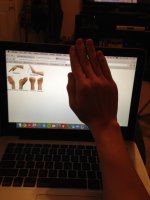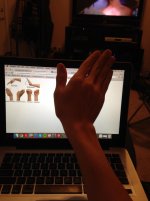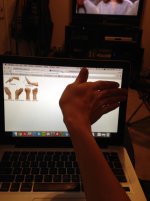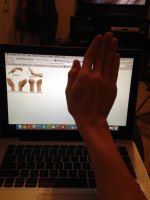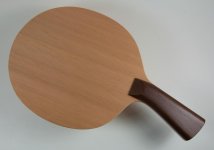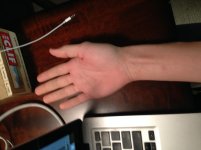Anyway, I will spill the beans a little and explain what I am seeing, even though a more relaxed arm would show things more clearly.
Regardless of which way your hand is facing, your ulna is on the pinky side of the hand and your radius is on the the thumb side of your hand. The radius and ulna are the two bones that make up your forearm.
The word longer and shorter here are not accurate but I am going to use them anyway because I don't want to waste time explaining the elbow joint and how the radius and ulna function.
For most people the radius extends further dismally in the forearm than the ulna. I know anatomical terms: what the heck did he just say. The radius appears longer than the ulna. So, for a normal person, if you took an image like an X-Ray of a normal person's forearm and wrist joint, the radius on most people's would extend past the ulna by a little and the head of the radius is a much larger surface in your wrist joint than the ulna bone surface. And the radius is angles to meet the ulna.
For most people the ulna is not much "shorter": the radius is not much longer.
In this image (a drawing):
In the image, you can see the radius goes farther than the ulna.
If I had X-Ray photos of the bones of 100 different people's hands, the angle from radius to ulna would be a bit different for each. There may be a few (maybe 3-4) where the ulna was "longer". There would be some where they were pretty much even. But not that many. Then most of the wrists would have the radius varying amounts longer.
Shuki, your wrist is not that extreme. It is mildly on the side where the radius is "longer" than the ulna by more than is common. But it is totally a normal range of deviation.
So, when your wrist and hand are in that position that looks like ulna deviation and your hand is lined up with the line of your wrist-crease, that is the neutral position for you. It is not ulna deviation. When your wrist goes to ulna deviation it looks like an extreme deviation. But it is just a normal deviation for the shape of the bones in your wrist.
When you do radial deviation, because of the "length" of your radius and the shape of your wrist joint, it looks close to the neutral position for a lot of people. But for you, that is pretty extreme radial deviation.
AND YOU SHOULD NOT BE TRYING TO GRT YOUR WRIST TO GO FARTHER IN THAT DIRECTION. Doing so could damage the ligaments that hold your carpal bones together and cause your carpal tunnel to collapse: in other words Big Bad, Strong Bad.
That is most likely why, the stuff you have been trying to do, has been hurting your wrist. And why you can't keep your wrist in that position.
When we hang out, I will have a look and show you normal ranges of movement for your wrist and demonstrate to you that even though your wrist joint is different than most people's, it is actually fine and should not get in your way in real life or in playing table tennis.
And, in a table tennis stroke, you most certainly do not want your racket to be "ahead of" your hand anyway. In line with, or behind, yes. Ahead of, no. [emoji2]
I couldn't resist. Here is the reason that longer and shorter are REALLY the wrong terms:
That is your elbow joint. The bone that wraps under and around the head of the humorous (upper arm bone) is the ulna. And on this side it extends significantly father proximally than the radius. So, if you measured the full length of the ulna and the radius, the ulna would actually be the longer bone and it would be noticeably longer even on someone who had a more angled wrist than Shuki. But at the wrist joint the radius, for most people, extends farther distally.
Sent from Deep Space by Abacus






